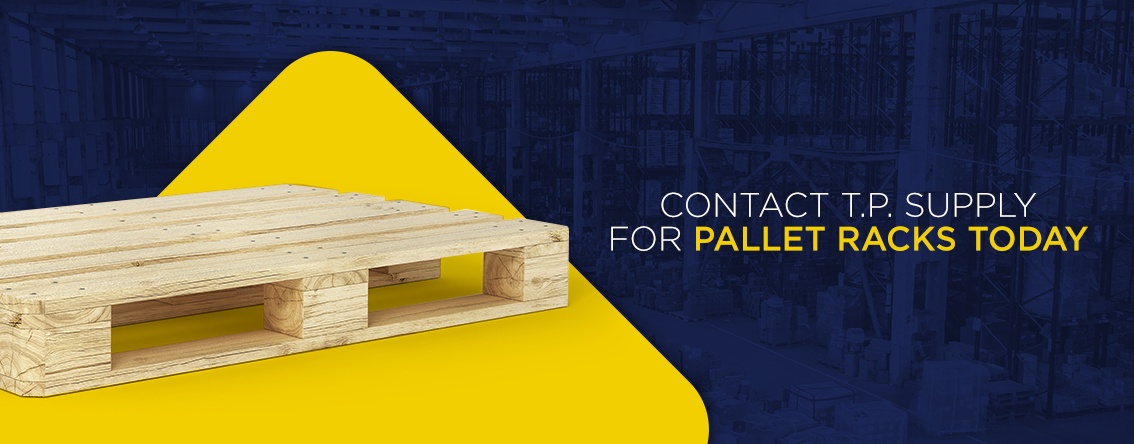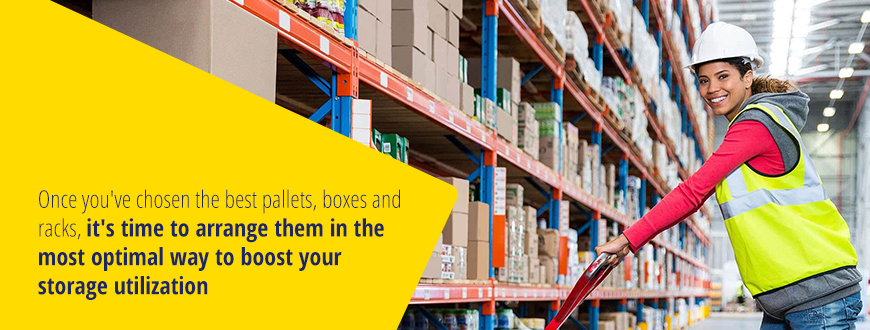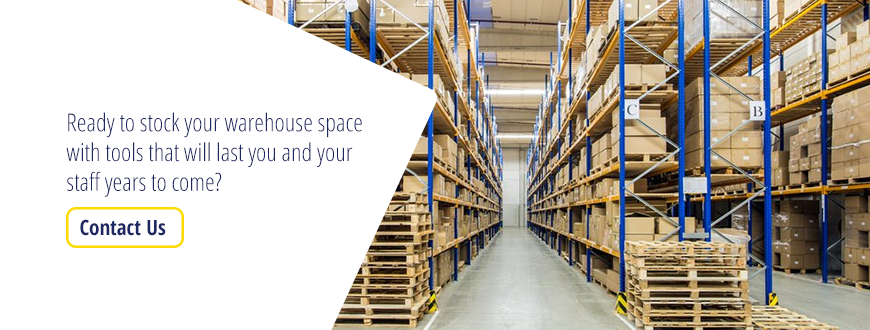Tips for Maximizing Your Warehouse Storage Capacity

Go back and read “how to calculate storage capacity“, so you can run the numbers on your own facility. If your storage cube falls outside that 22% to 27% range or you’re unhappy with the number you reached for the amount of potential storage space you’re actually utilizing, it’s time to focus on your warehouse capacity optimization. By making a few small changes to the layout and organization of your space, you can increase your warehouse utilization numbers and save both money and time. Here are six tips you can apply to your facility to maximize the storage capacity of your warehouse and utilize as much space as possible.
1. Use the Right Storage Solutions
The types of storage solutions you use at your warehouse will have a direct impact on your storage utilization. To reach optimal storage capacity, choose solutions that make sense for the shape and size of your space as well as the types of products you’re storing.  Some popular storage utilization-enhancing solutions include:
Some popular storage utilization-enhancing solutions include:
- Pallet racks: Pallet racks are common storage solutions for warehouses because they allow staff and machinery to access goods directly. Pallet racks are also adaptable and customizable to a range of product sizes and weights, making them compatible for most facilities. These steel racks can come with either welded or bolted frames.
- Drive-in pallet racks: Drive-in pallet racks use the LIFO method — the last product to enter the rack is the next to be picked. This makes drive-in racks ideal for temporary storage solutions and high-volume inventories.
- Drive-thru pallet racks: With double-sided points of entry in both the back and front for product entry and removal, respectively, drive-thru pallet racks utilize a FIFO system — first in, first out. This racking unit is typically found in the middle of the storage and order fulfillment process.
- Mezzanines: A mezzanine is an excellent way to double or potentially triple the surface area of your warehouse that can be utilized for storage. It essentially serves as another floor within your warehouse, allowing you to increase your storage area without any construction or expansion. Mezzanines are ideal for storing odd-shaped products or serving as an assembly or sorting area. While mezzanines cannot replace pallet racks, they are an excellent complement.
- Flow racks: Flow racks also follow the FIFO system, making them ideal for storing perishable goods that are frequently being rotated. Gravity will move the pallets on flow racks as they are picked or moved, sliding the products on tracks until they reach the end of the rack.
- Mobile racks: Mobile racks operate by basically squeezing multiple rows of products together on guided bases that can slide laterally at an operator’s request. This means that the operator can move the racks left or right, creating an aisle anywhere within those rows to access particular products.
- Stacker cranes for pallets and boxes: Stacker cranes for boxes and pallets will increase your usable space vertically by allowing you to access stacks up to 131 feet high for pallets or 65 feet high for boxes. These machines can also operate in relatively narrow aisles — 5 feet wide for pallet cranes and 3 feet wide for box cranes. These machines also move quickly to increase productivity and are compatible with pallets and boxes of all sizes.
2. Rearrange Your Aisles, Pallets and Racks
Once you’ve chosen the best pallets, boxes and racks, it’s time to arrange them in the most optimal way to boost your storage utilization. Keep like-sized items and storage units together for the best organization and fit. Make your aisles a bit more narrow to fit a few more rows in — as long as they’re still wide enough for your staff and equipment to fit through comfortably and efficiently. Not only will having a well-organized warehouse increase your storage capacity, cube size and overall utilization, but it will also increase your employees’ efficiency as they will be able to move around and find items easier. The same goes for any automated machinery you use in your facility. 
3. Increase Your Clear Height
The clear height of your building has a significant impact on the amount of storage space you have available to you. While it may seem difficult to increase the amount of space you have vertically, it’s possible to boost your clear height by looking at any equipment, infrastructure or other items you have hanging from the ceiling. For example, you might have hanging lights, security systems or cameras, or other items that you can move, replace or reposition to give you a few more feet of clear space. Rather than hanging lights and security systems from the ceiling, consider affixing them to the actual roof or walls to maximize your clear height and, therefore, your potential storage space.
4. Account for Fluctuation Due to Seasonal Inventory
If your warehouse stores a lot of seasonal products, such as holiday decorations, beach gear or winter gear, be sure to account for this fluctuation during the off-seasons. While the total storage utilization of a facility that houses mostly Christmas decorations may be lower during the summer, that doesn’t mean they aren’t doing well or even that they should revisit their warehouse optimization plan. If the managers of this warehouse were to instruct higher-ups that their storage utilization was low and they needed more products to store, they would likely be way over-stocked come winter. Warehouses with significant amounts of seasonal inventory should ideally calculate an optimal storage utilization for their peak season, as well as an optimal storage utilization number to shoot for during the off-season. It simply wouldn’t make sense for them to keep the same amount of product in the facility all year-round, but it also wouldn’t make sense to rearrange the warehouse twice a year to suit the fluctuation in inventory.
5. Allow Room for Growth
Another reason the total storage cube of your warehouse shouldn’t be more than 27% is to allow room for growth and new products. If your warehouse is at full storage capacity and utilization, that’s a good sign that it’s time to expand. Always allow some room for quick growth at your warehouse — you never know when a product of yours will go viral overnight. If that happens, you’ll need to start overstocking that particular item as soon as possible to keep up with demand. It’s a good problem to have, but it’s even better when you’re prepared to handle it.
6. Avoid Estimating Warehouse Storage Capacities
Your warehouse storage capacity is not a number you want to “guess” on. Avoid estimating your storage capacity or “eye-balling” how much of the facility you’re using for storage. Now that you know the calculations and how to reach an exact number for your warehouse storage capacity and utilization, take the time to do the math and figure out the logistics of your space. Knowing your numbers will allow you to develop the most efficient warehouse optimization plan in terms of both its layout and organization.
Contact T.P. Supply Co. for the Tools and Supplies You Need
Once you’ve calculated your warehouse space and storage capacity, it’s time to fill your facility with the premium supplies and tools it needs to operate smoothly and efficiently. From storage rack and shelving solutions to material handling tools and machinery, our product offerings combine excellent safety and security features with durability and superior quality to create an effortless experience for the user. Ready to stock your warehouse space with tools that will last you and your staff years to come? Contact our team today for more information about our product offerings and how they can be an asset at your facility.


